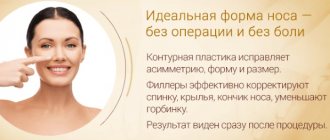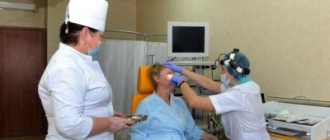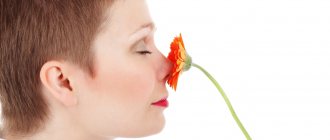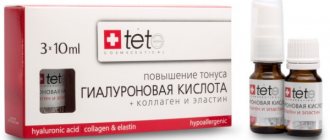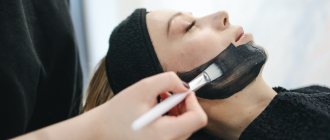Before you decide on such a responsible procedure as surgery to change the shape of your nose, think about whether there are more painless and cheaper ways to bring your nose into the desired shape. We have written a special article on non-surgical methods of rhinoplasty. We advise you to familiarize yourself with it before spending huge sums and going under the doctor’s scalpel.
An operation such as rhinoplasty of the nose is considered a common type of surgical intervention with maximum cosmetic risks. The consequences of nose rhinoplasty are based on the unpredictability of the aesthetic result. And their manifestations can be expected at any stage - during surgery, during rehabilitation and after a certain period. Please note that after rhinoplasty in men, rehabilitation is easier and the risk of negative consequences is less.
In addition to the aesthetic risk, there are negative consequences for the patient’s general health, short-term and long-term side effects. They can manifest themselves depending on the individual characteristics of the patient and with various aggravating factors.
Indications and contraindications. Are there non-surgical rhinoplasty methods?
There is often a situation when, after an examination, the doctor can recommend to the patient two operations, rather than one - rhinoplasty along with septoplasty: such a complex operation involves both aesthetic changes (rhino-) and work with the nasal septum (septo-).
“Rhinoplasty corrects congenital or acquired aesthetic defects of the nose as a result of injury or an accident. Septoplasty is done for medical reasons, in order to improve breathing if there is a curvature of the nasal septum,” the expert clarifies.
According to Aram Grigoryan, rhinoplasty should always be accompanied by improved breathing. And any qualified plastic surgeon who has experience in this field always takes this point into account. At a minimum, rhinoplasty should not worsen breathing. Therefore, in 90% of cases, this will be a rhino-septoplasty operation: work with external changes and rhinoplasty of the septum.
Contraindications for nose surgery can only be general medical ones. Or if your plastic surgeon does not see the need for surgery or understands that he will not make a better nose than the existing one. In this case, the surgeon has the right to refuse the patient.
“As for non-surgical rhinoplasty, it is rather a cosmetic procedure to correct minor imperfections, such as a small hump. In some cases, it can be used, but very carefully, without touching the vessels and ligaments. Gel fillers injected into the nasal tissue create pressure and compression on important nasal structures and can even promote atrophy,” says Aram Grigoryan.
Patient Responsibility
If the claims relate to the size and shape of the nose, then it is almost impossible to prove the patient is right, since each operation has its own capabilities and limitations.
Therefore, in such cases, computer modeling technology is used, where the patient can see the expected result, after which he will sign a contract and agree to the terms.
Another important aspect is the rehabilitation period. During the specified period of time, the patient receives a set of strict rules that must be followed.
If it turns out that the patient neglected any conditions or violated the instructions, then the responsibility will fall entirely on his side and the doctors will prove that they are right.
For example, it is forbidden to wear any glasses for 2-3 months after surgery - they can injure the bridge of the nose or affect its shape during healing.
Such consequences of rhinoplasty do not fall under the responsibility of the clinic, as do injuries or the development of pathologies due to infectious or other diseases.
What is closed rhinoplasty?
Closed and open rhinoplasty of the nose are two different methods of nose correction. In open rhinoplasty, the surgeon makes an incision and separates the skin over the cartilage. Access to the nasal septum is as convenient as possible; the septum itself can also be removed for correction and then returned to its place and secured to the bone.
The closed method is more gentle and involves fewer incisions. Unlike open rhinoplasty, this method does not damage the arteries near the tip of the nose and the recovery period will be shorter. The soft tissues are stitched together, leaving almost no scars.
Expert opinion
- Cosmetologist
- Surgeon
Irina Dorofeeva
practicing cosmetologist
It is worth understanding that rhinoplasty is a serious operation that must be performed by an experienced doctor. Before you go to the surgeon, think carefully, because it will be impossible to return the previous appearance of your nose. In addition, it is worth understanding that after the operation the result will not be visible. To do this, you should wait up to six months and undergo long-term rehabilitation. If, after all, you decide to undergo rhinoplasty, choose a good doctor.
Margarita Eiten
plastic surgeon
The initial consultation, which takes place before surgery, is important for further results. It is worth trying to tell the doctor exactly about the desired result. The surgeon must understand exactly what the patient wants to achieve. In addition, a good specialist will definitely ask if there are any breathing problems, allergies, or what medications the patient uses. If the doctor is not interested in such nuances, then you should think about his competence. If the operation is performed by a good specialist, then you should not be afraid of a negative consequence, since the risk of its occurrence is very low.
Can any nose shape be made “to order”, for example, based on fashion trends?
As with other plastic surgery, trends in rhinoplasty exist. Today, social networks play a big role in creating “fashionable” nose trends. Unfortunately, patients do not always understand that photographs on the Internet are a lot of artistic work, a high percentage of retouching, corrections, correct lighting, and the work of a stylist and makeup artist. It doesn't look like this in real life. “We have to explain that these “sharpener” noses are not so good in real life,” explains the expert.
If the patient came with a specific ideal vision of his nose, for example, brought a photo of his favorite actor, then the surgeon, of course, will do everything to come as close as possible to the desired shape. But a lot also depends on the initial data and anatomical features of the patient. If, for example, a person has thick, porous skin, and he wants a chiseled small nose, like on Instagram, then such a result is hardly achievable.
Scientific research by Gerhard Rettinger
From Dr. Gerhard Rettinger's study "Risks and Complications of Rhinoplasty" there is data on 184 consecutive revision rhinoplasties (out of a series of 502 consecutive septorhinoplasties) performed by a single surgeon.
In this study, revision (i.e., repeat) surgery was the second procedure (first revision) in 61%, third surgery in 22%, fourth surgery in 10%, and fifth surgery in 2%.
5% of patients had more than 5 previous operations.
Only 15 of these 184 "repeat" patients were the doctor's primary patients. That is why the preoperative deformation and indications were not always known to him.
Most of these patients had functional and aesthetic complaints.
It was found that the indication was primarily aesthetic in 32%, while in 24% it was purely functional (septum only), resulting in visible deformities.
It is well known that the consequences of septoplasty can occur in 21%. The majority of patients in our series (44%) had a combination of functional and aesthetic problems.
Other indications included infections (septal abscess), malformations (nasomaxillary dysplasia) and others (eg, previous pituitary surgery).
What is nasal tip rhinoplasty?
Rhinoplasty of the tip of the nose is a partial correction of the shape of the nose, affecting only this part. The surgeon may recommend it as more gentle. This operation is indicated for patients whose nasal tip is irregularly shaped from birth, for example, teardrop-shaped, forked, hooked, curved from birth, disproportionately wide, has too wide, or less often too narrow nostrils. You can also change the angle of your nose. For a plastic surgeon, this is jewelry work; every millimeter is important. As in other cases, the patient’s initial anatomy, the condition of the cartilage and the thickness of the skin play a big role.
As follows from the above, with this method of correction, problems with a hump on the back of the nose cannot be solved. This will require more thorough intervention. The advantages include the possibility of local anesthesia.
When is it time to see a doctor?
There is a type of complication called perforation of the nasal septum. This is a dangerous pathology that can lead to irreversible consequences if it is not eliminated in time.
The main symptoms are a whistling sound when inhaling and exhaling through the nose, as well as constant congestion and difficulty breathing.
If you notice a feeling of dryness and discomfort, pain in the nasal cavity, bleeding or purulent discharge with an unpleasant odor, you should immediately consult a doctor.
Delay in resolving this issue can deprive the sense of smell and lead to other serious consequences.
The pathology should be studied by a surgeon and an ENT doctor, who will be able to select the optimal treatment.
What are the stages of recovery after rhinoplasty?
“The rehabilitation period after rhinoplasty surgery is divided into several stages. The first is about two weeks, from 7 to 14 days. These days the patient wears a plastic splint. Bone consolidation occurs and maximum post-traumatic edema disappears. The partition contains splints - silicone plates; at the end of the first stage we remove them. When we removed the splint, the main rehabilitation was completed,” says Aram Grigoryan.
The next stage begins when the main swelling has gone. We have already received the shape of the nose after rhinoplasty that we wanted, all the changes are as visible as possible, the patient likes everything. But minimal swelling remains, and it remains at the tip and dorsum of the nose. After about 3-6 months, 60% of the swelling goes away. The remaining 20-30% of the swelling may take up to a year to go away. “Again, if the skin is thick or it is a revision rhinoplasty, swelling may remain longer and rehabilitation may last 1.5 years, or 2, or even more,” the expert assures. “If the skin is thin, rehabilitation will be noticeably faster.”
Also, the speed of the rehabilitation process depends on the skill of the surgeon and the correct choice of anesthesia. The larger the area of the operation and the tissue trauma, the greater the swelling, and the longer the recovery period. All this affects the shape of the nose. If during the process of rhinoplasty the surgeon did the work carefully, scrupulously, especially in the layers, the swelling is minimal, then rehabilitation will go much faster.
“The swelling itself can be removed; the doctor will individually select a drug for you for this. Plus physiotherapy and massages. If the swelling is uniform and corresponds to a certain time of the rehabilitation period, then it is not necessary to do anything with it, it will go away on its own. Visually, swelling does not draw attention to itself,” our expert comments.
Question answer
Often, mistakes occur due to the doctor’s lack of experience or a poorly selected surgical method. In addition, you can encounter unpleasant consequences if you violate the rules of care after the intervention. We strongly recommend that you carefully select a medical institution and a doctor!
To have a repeat rhinoplasty, you will have to wait at least a year.
No. To begin with, you should wait until the gel is completely absorbed. This usually takes up to 8 months. Earlier surgery is impossible, since the surgeon will not be able to predict the exact result.
How often and what are complications and can they be avoided?
Complications after surgery can be divided into two types. The first is general surgical, such as inflammation, suppuration, bleeding. This happens with absolutely any operation. The patient is informed about them when signing the contract. The clinic takes responsibility for creating sterility in the operating and post-operative units. The patient, in turn, undertakes to follow all recommendations of the rehabilitation period prescribed by the doctor.
The second type of complications is dissatisfaction with the resulting shape of the nose, although, strictly speaking, this is difficult to attribute to medical complications. These are rather undesirable phenomena. They are also divided into two types: the first is the patient’s own perception, the second is clearly expressed defects. Obvious signs of unsuccessful rhinoplasty include curvature, recessed tip, and breathing problems. This needs to be adjusted, but not earlier than six months later.
A surgeon always deals with a living organism and it is difficult to predict how this organism will behave in a given situation. There is always a chance that something will go wrong. We are, of course, not talking about obvious noticeable defects. Even with a competently performed operation, as correct as possible, the result may be unsatisfactory. “For example, there was a large curvature of the nose, it was straightened and fixed. But living tissue has the concept of “shape memory,” the phenomenon of returning to its original state. This is unpleasant, but fixable. If there is a dialogue between the patient and the doctor, they hear each other, then in the postoperative period this can all be resolved by certain procedures. Dialogue between doctor and patient is 50% of a successful result. There are no impossible tasks, almost all problems are solvable,” says Aram Grigoryan.
World community experience
All over the world, rhinoplasty is considered an operation associated with many risks, since the expectations of the patient and the doctor are not always met.
In addition to postoperative deformities, many other risks and complications must be considered.
Reduction rhinoplasty, for example, can cause breathing problems, which are reported by 70% of all revision rhinoplasty patients. However, you need to know that scars and loss of sensitivity in the mucous membrane can give a feeling of a “blocked nose”, which goes away after some time.
Silicone implants can have a complication rate of 5 to 20%. Fewer complications have been reported with other materials such as Gore-Tex.
Complications of the skin and soft tissues can manifest as atrophy, fibrosis, numbness, and cysts.
Infections are rare but sometimes life-threatening (toxic shock syndrome).
Also, discoloration of incisors is possible due to damage to blood vessels and nerves.
There is a whole list of various other risks that we will not scare you with, since the cases are rare.
Postoperative deformities are considered the main risks of rhinoplasty, prompting revision (repeat) surgery in 5-15% of cases.
Rhinoplasty “before” and “after” photos: should you trust such photos?
Photos of profiles of operated patients are a separate genre. Each plastic surgery clinic has in its arsenal more than a dozen such photo collections. However, for anyone who decides to undergo surgery to correct the shape of the nose and has already decided where to have rhinoplasty, it is important to remember that more than one month passes between the first and last photo. The bruises and swelling have already gone away, the nose has “fallen back into place”, the patient has rested, tidied up his appearance, maybe even changed his hairstyle. On the Internet you can find many stories of how girls were finally able to afford a certain haircut after nose reduction surgery. It's no secret that a large nose does not always decorate a girl's face. A small upturned nose is in fashion.
When a person is not ready for a fairly long rehabilitation period and wants to get a new nose in a month, disappointment may set in. A real nose after rhinoplasty behaves like a living organism and does not always live up to the expectations placed on it. This moment is fraught with conflicts with the surgeon and the medical organization as a whole.
There is only one conclusion here: the ideal result in a photo is half an artistic creation, so if you want to get a new nose shape, be patient, stay in touch with your surgeon and strictly follow all his recommendations. Believe me, the specialist is no less interested in a successful result than you are.
Patient reviews
OKSANA, 26 YEARS OLD, MOSCOW:
“I’ll tell you my terrible story.
I had a complex procedure and suffered from several problems at the same time. Firstly, I had a deviated septum from birth and I could not breathe normally. The bridge of the nose and the bone were slightly curved, but this defect became visually pronounced after I was injured in sports. On top of that, I suffered from sinusitis (sinusitis) and it got to the point where I needed to have my sinuses pierced.
And now, the situation had already become frankly critical, I agreed to the operation. Let me tell you right away that it was done for me through insurance, and it cost the sports federation 350 thousand rubles. For me this is a fabulous amount, I would not have been able to do it myself.
But we chose a good clinic, the operation was successful, I lay under anesthesia for 3 hours, the surgeon later said that it was a difficult case, but everything worked out. At least at that time.
I, as a devoted fan of my business, went to training a month later, and what do you think? Yes, I got hit in the nose again. The bone remained intact, the septum shifted.
On the same day I contacted the surgeon, he made an appointment for the evening and began to reduce it. Honestly, I have never experienced such pain in my life. They did it live; there was no point in going to bed under general anesthesia because of this. The main thing is that we fixed it.”
ILYA, 42 YEARS OLD, MOSCOW:
“When I was a child, cartilage was removed from my nose.
These are the doctors we came across and said that he was not needed. I don’t know how my mother agreed to this, she is a trusting person, but as a result, I lived with a flat nose until I was 35 years old. I had an implant inserted instead of cartilage, and it felt great. If I had known that the problem could be solved with a repeat operation, I would have agreed sooner.”

